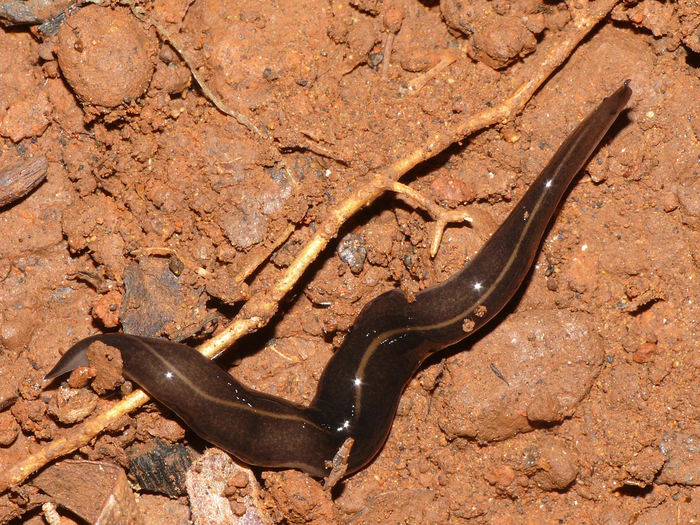A review of decades of research revealed more than a dozen kinds of animals in addition to slugs and snails have caused rat lungworm disease in people around the world.

Credit: Shinji Sugiura.
A review of decades of research revealed more than a dozen kinds of animals in addition to slugs and snails have caused rat lungworm disease in people around the world.
Researchers from the University of Hawai‘i at Mānoa and the University of London (UK) combed through nearly 140 scientific studies published between 1962 and 2022 and found 32 species of freshwater prawns/shrimp, crayfish, crabs, flatworms, fish, sea snakes, frogs, toads, lizards, centipedes, cattle, pigs, and snails can act as carriers of the rat lungworm parasite (Angiostrongylus cantonensis). Of these, at least 13 species of prawns/shrimp, crabs, flatworms, fish, frogs, toads, lizards, and centipedes have been associated with causing rat lungworm disease in humans.
This work was the master’s degree thesis research of the first author, Helena Turck, as part of a graduate program in One Health jointly run by the Royal Veterinary College and the London School of Hygiene and Tropical Medicine, both part of the University of London, UK. Robert Cowie, senior author on the study and faculty member in the UH Mānoa School of Ocean and Earth Science and Technology (SOEST), supervised Turck’s research remotely during the pandemic and co-authored the new publication. Professor Mark Fox of the Royal Veterinary College is also a co-author of the study.
Cowie explained that the rat lungworm has a complex life cycle that involves slugs and snails as so-called “intermediate” hosts and rats as “definitive” hosts in which the worms reach maturity and reproduce. Rats become infected when they eat an infected snail or slug. People also become infected when they eat an infected snail or slug, and this can lead to serious illness and occasionally death.
Humans, accidental hosts
“But people can also get infected if they eat so-called paratenic hosts, which are also known as carrier hosts,” said Cowie, who is a research professor in the Pacific Biosciences Research Center at SOEST. “These are animals that become infected by eating infected snails or slugs, but in which the worms cannot develop to maturity as they do in a rat. However, in such hosts the worms become dormant, but still infective. And if one of these hosts, or part of one, is then eaten raw by a person – an accidental host – development can continue, but only up to a point.”
That point is when they are in the person’s brain, where they are moving around, feeding, and growing. But then the worms die. The damage to the brain and the massive inflammation that results when they die is primarily what causes the symptoms of rat lungworm disease.
“It is important to know not only that snails and slugs can transmit rat lungworm parasites to humans but also which other animals – which paratenic hosts – can also do so,” Cowie said. “So the goal of the study, was to pull all the information on paratenic hosts and their role in transmission of rat lungworm disease, previously scattered in diverse publications and obscure reports, together into one place and develop a global understanding of their diversity and role in disease transmission.”
Rat lungworm disease around the globe
Rat lungworm disease is at present confined largely to the tropics and subtropics, notably parts of South and Southeast Asia, where it probably originated, southern China, Taiwan, southern Japan, various Pacific islands and archipelagos, and more recently Brazil, Caribbean islands, and Australia. The parasite has also been reported from the Canary Islands and Balearic Islands of Spain, as well as southeastern parts of the United States, where there have been a handful of cases of rat lungworm disease. Climate change may lead to its further spread into currently more temperate regions.
Hawai‘i is a global center of the incidence of rat lungworm disease, and indeed it was in Hawai‘i where the connection between the parasite and the disease was first discovered, by University of Hawai‘i and US government scientists in the early 1960s.
“Several species capable of acting as carriers (paratenic hosts) are present in Hawai‘i, including flatworms, centipedes, coqui frogs, and cane toads,” said Cowie. “While people in Hawai‘i are unlikely to eat these animals, it is not unknown for people to do so on a dare, and become seriously ill. Elsewhere, certain paratenic hosts are eaten for supposed health reasons – frogs in Taiwan and Japan, or to enhance virility – lizards in Thailand.”
Domestic animals, especially dogs and horses, can also become infected by the rat lungworm parasite, including in Hawai‘i, probably mostly from accidentally or deliberately eating snails or slugs.
Preventing infection
There are several things people can do to prevent infection by rat lungworm.
“Awareness of which species may harbor the parasite is critically important both in Hawai‘i and more widely,” said Cowie. “These animals should not be consumed raw. Additionally, wash all fruits and vegetables well under running water and inspect them for slugs, snails and possible other hosts such as flatworms so as to avoid inadvertently eating them or parts of them.”
Journal
One Health
DOI
10.1016/j.onehlt.2022.100426
Method of Research
Literature review
Subject of Research
Not applicable
Article Title
Paratenic hosts of Angiostrongylus cantonensis and their relation to human neuroangiostrongyliasis globally
Article Publication Date
6-Aug-2022
COI Statement
All authors declare no conflicts of interest.




